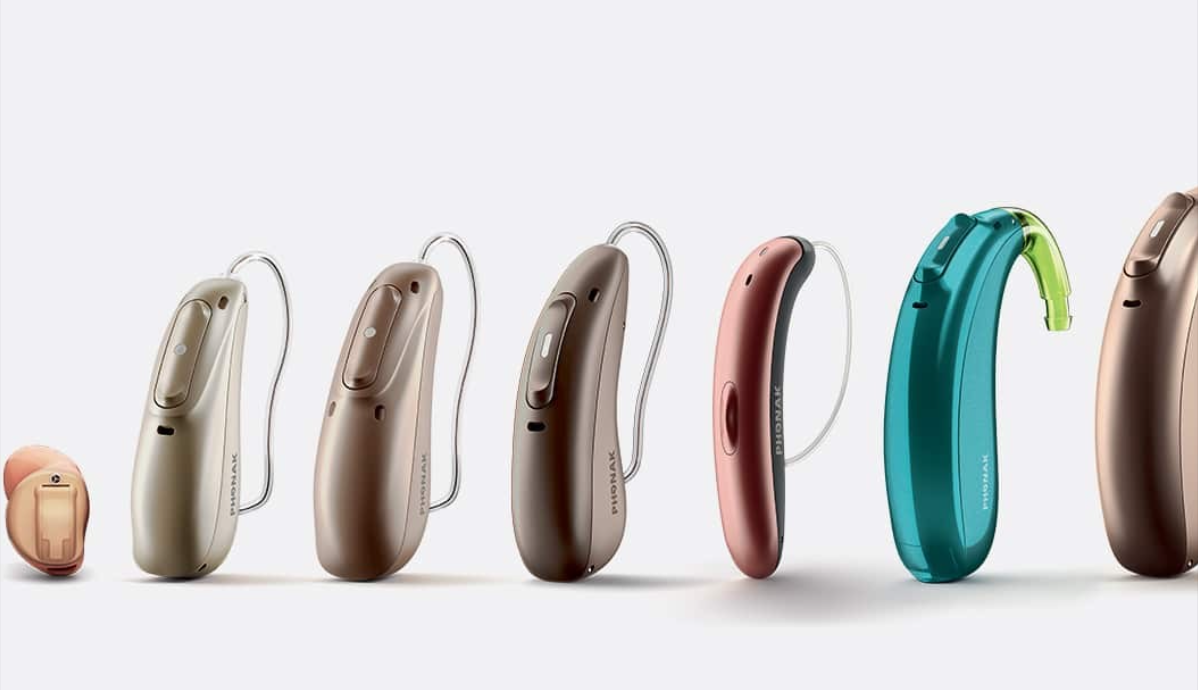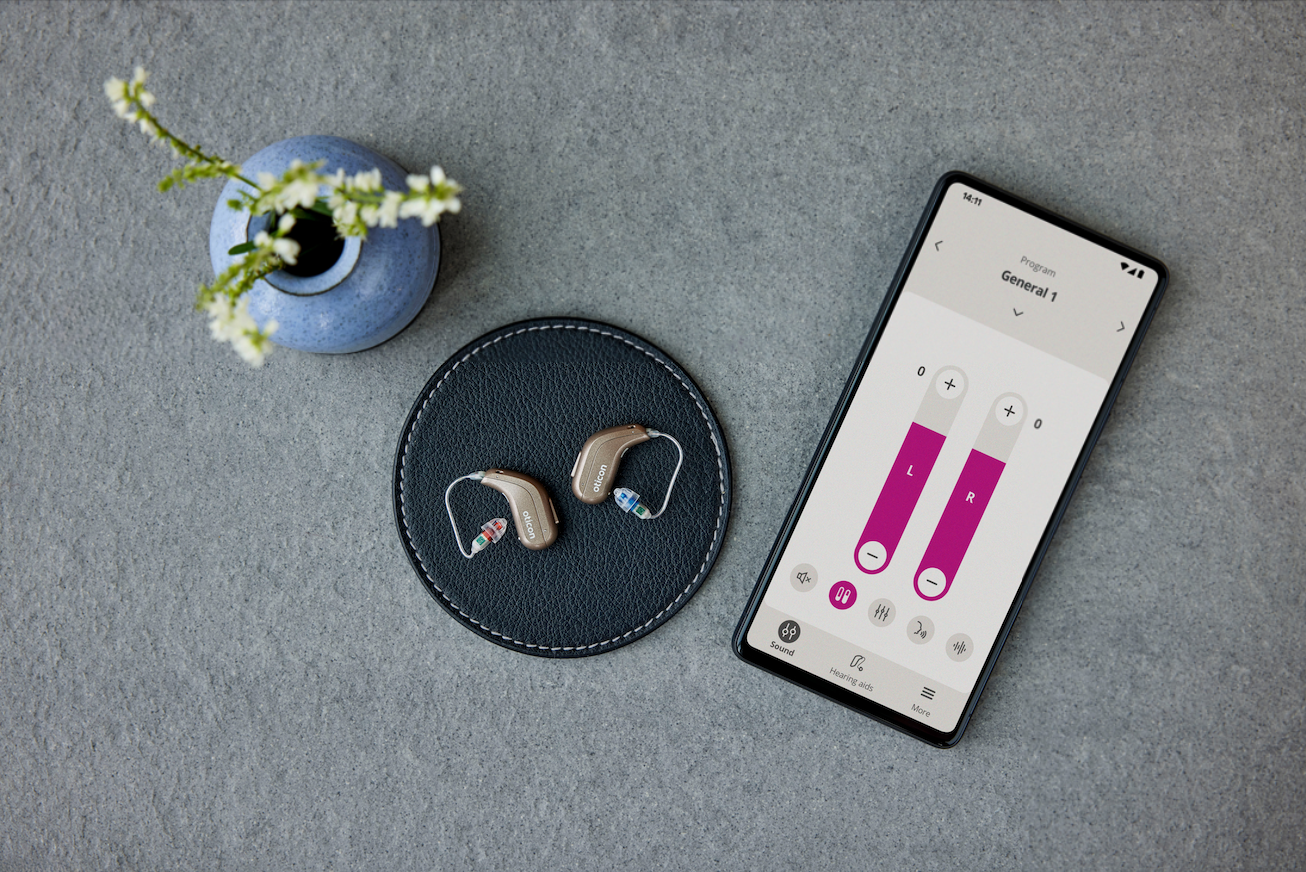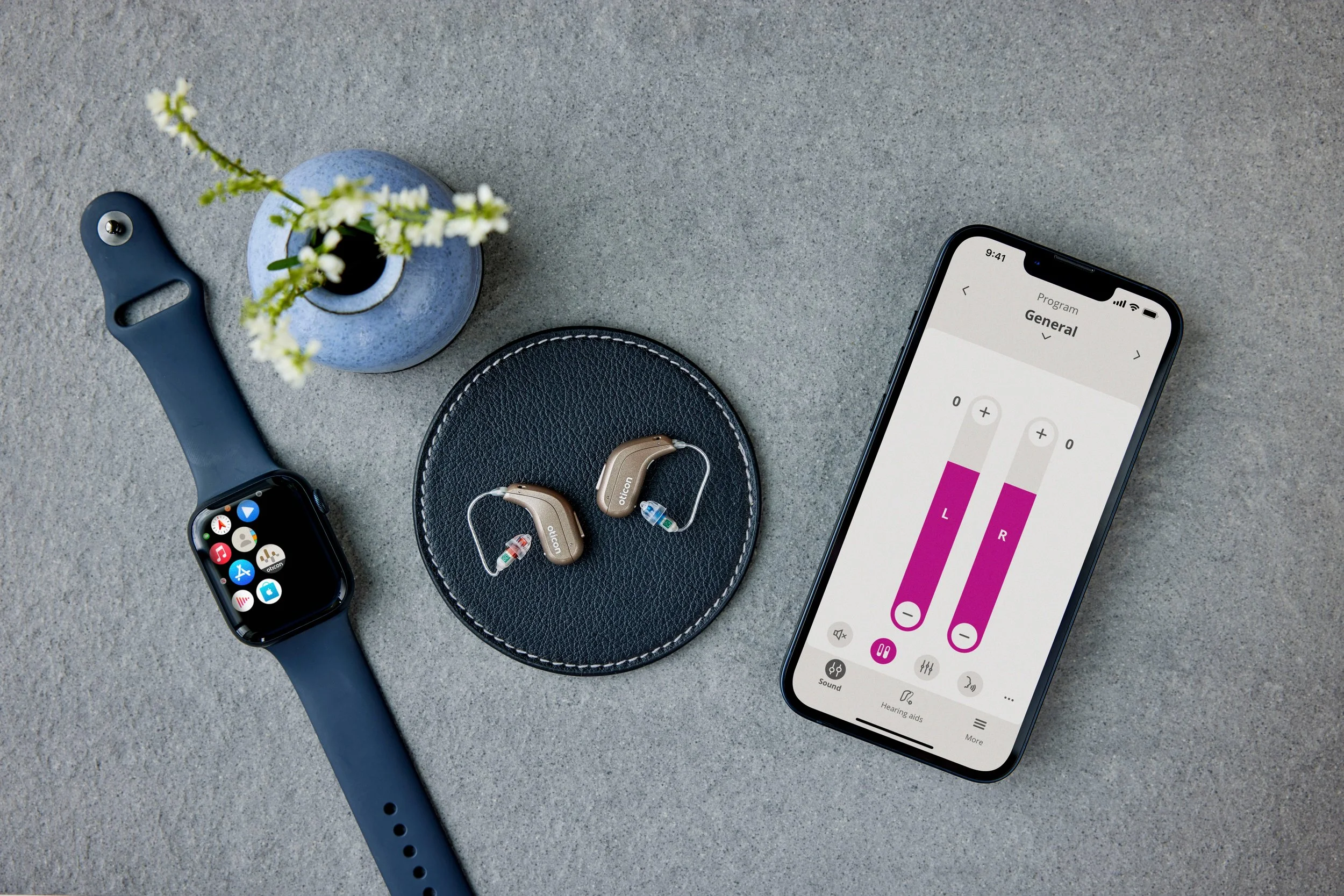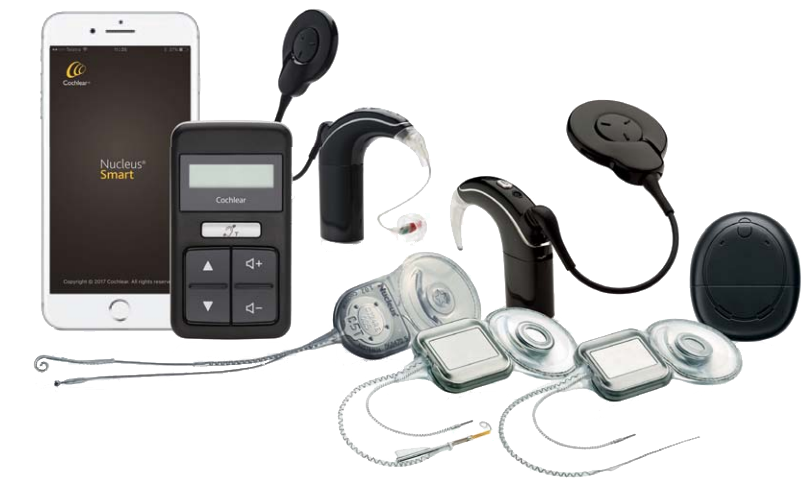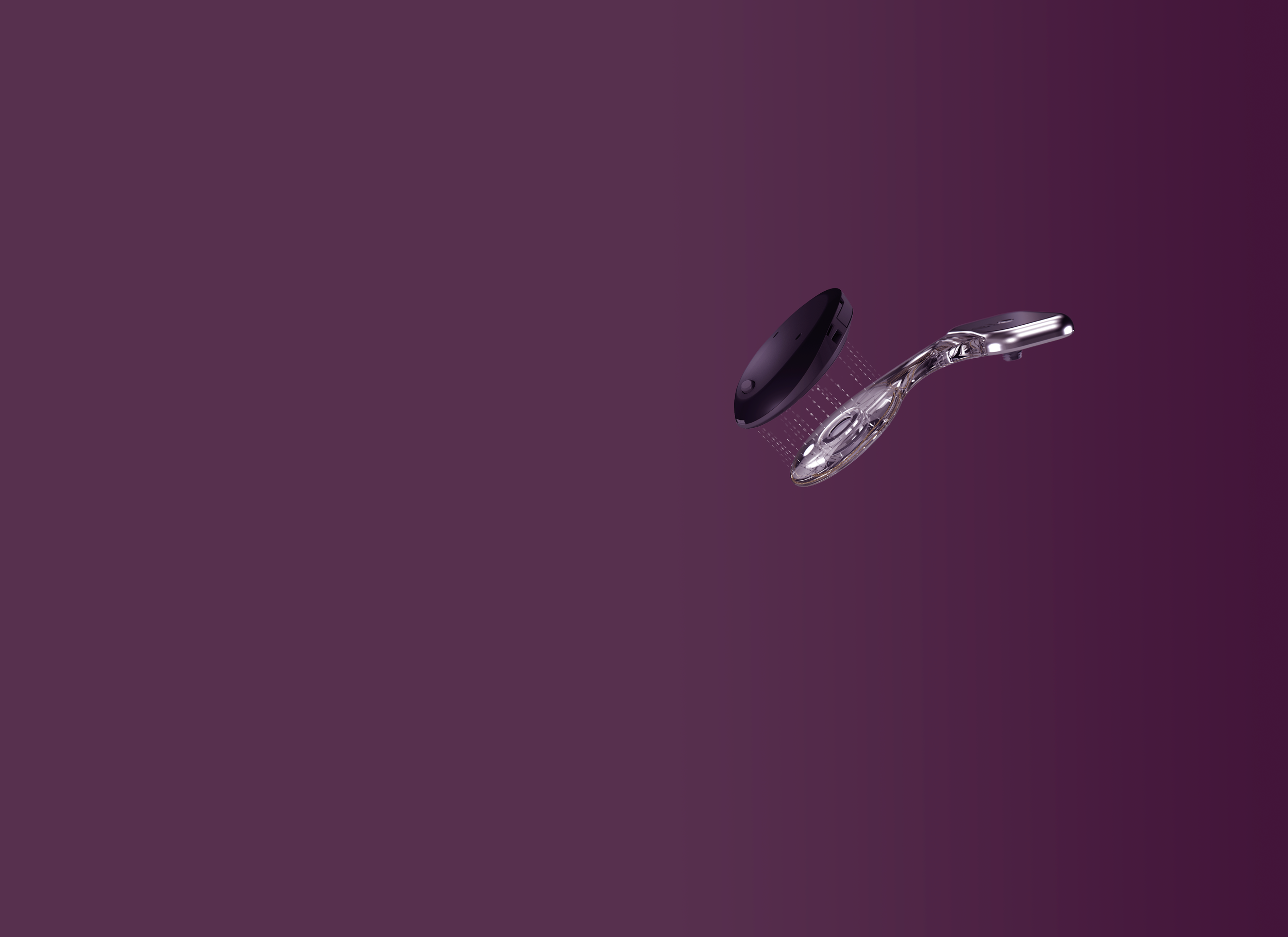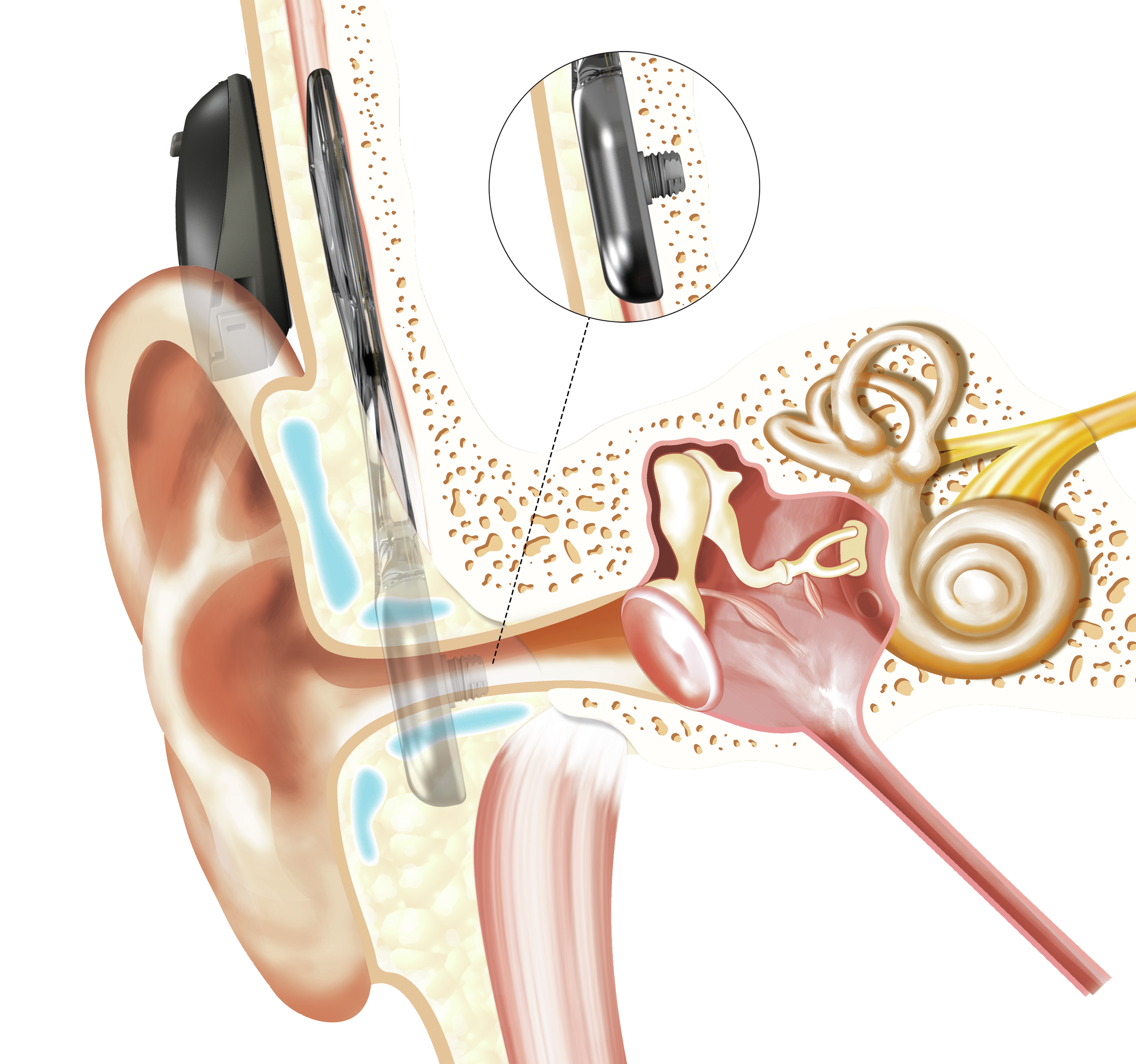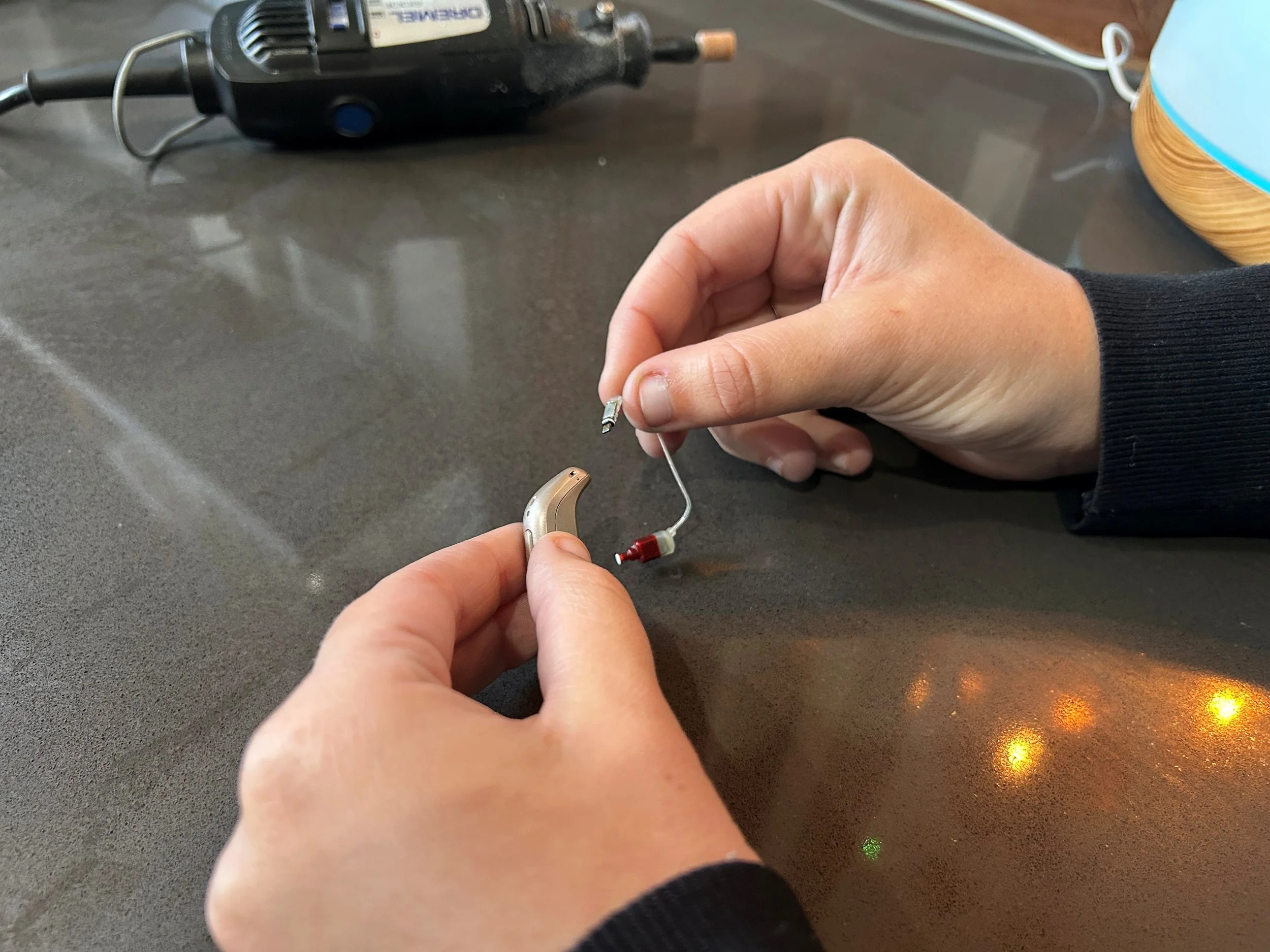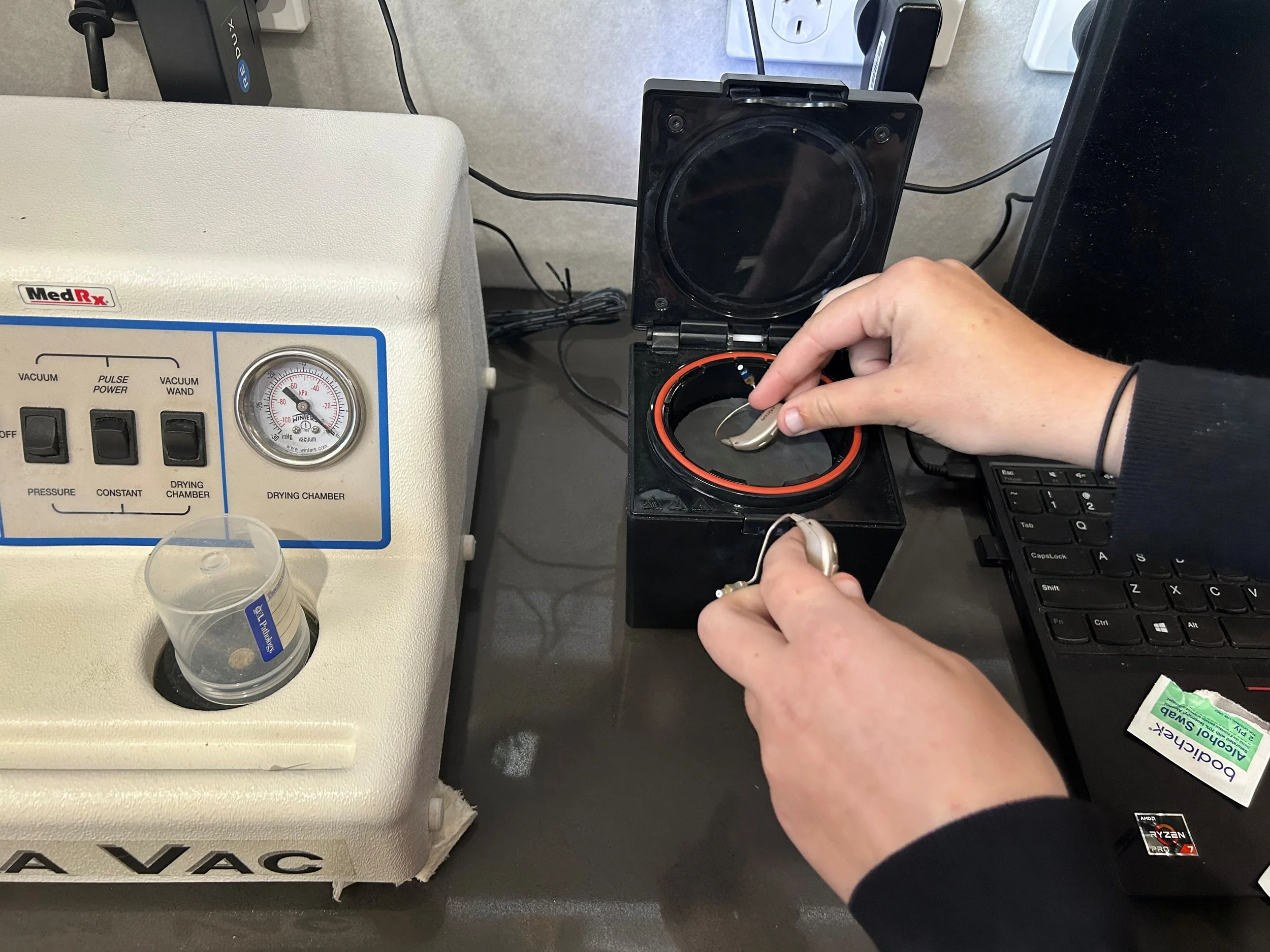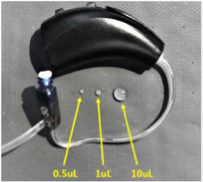Hearing Devices
Hearing devices help by making speech louder and clearer and can help you reconnect with your loved ones and improve your quality of life. Studies show that people who wear hearing devices maintain better relationships, have more self-confidence and experience more independence and security.
Research shows that constant stimulation is key in maintaining neurological (brain) health – almost a ‘use it or lose it’ situation. Hearing forms part of this vital stimulation required for brain health.
There is a multitude of hearing solutions available from a range of manufacturers and in various styles, technology levels and even colours. Our team of hearing experts is here to help you navigate through the options, and help you find your ideal hearing solution.
The eligibility for hearing devices will be discussed with you at the hearing assessment appointment. All options of hearing devices, including implantable devices, will be considered to achieve the best outcome for your listening needs.
Hearing Aids
There is a multitude of hearing solutions available from a range of manufacturer’s and in various styles, technology levels and even colours. Our team of hearing experts is here to help you navigate through the options, and help you find your ideal hearing solution.
What Are Hearing Aids?
Hearing aids do exactly as their name suggests. They are highly sophisticated sound management and amplification devices that aid people’s hearing.
Hearing aid technology is continuously evolving, improving the listening ability and sound experience for people with hearing loss.
Modern hearing aids:
are programmed to your hearing loss – they only amplify the type of sounds you need to the level you need (hearing aids do not provide uniform amplification to all types of sound)
amplify quiet sounds, but do not over-amplify loud sound
make speech understandable while suppressing disruptive background noise in loud environments
allow you to recognise where sounds are coming from
are adjustable – all devices can be adjusted by our hearing-health practitioners to your acoustic preferences, and some devices can be adjusted by controls on the device itself, remote controls and/or through an app on your smartphone.
have connectivity – most hearing aids can be connected either via Bluetooth, 2.4GHz or LE audio to other devices, including your mobile phone (depending on compatibility of your mobile phone), to stream audio directly to your hearing aids.
rechargeability – jut like your mobile device, many hearing aids are powered by internal rechargeable batteries. Traditionally, hearing aids have been powered by button style batteries with limited lifespans of 5-7 days if worn all day. Rechargeable devices are more convenient, easier to handle and improve the reliability of the device as there is no more opening and closing of a battery door risking moisture or dirt buildup.
Hearing aid types
It is likely there will be a range of potentially workable hearing aid options available to you. However there will probably be a shortlist of devices offering the best possible outcome, based on the type and degree of your hearing loss, ear size and shape, lifestyle, budget and aesthetic preferences.
We will talk you through the advantages and disadvantages of suitable options, giving you all the relevant information required to make an informed decision. Ultimately, it is completely your choice which hearing aid brand, style and level of technology you are fitted with.
Mackay Hearing is a locally and independently owned hearing clinic – we are not tied to a manufacturer and we can fit you with any hearing aids from any manufacturer.
In saying this, we only supply devices from reputable manufacturers that are proven to consistently deliver positive outcomes. Therefore, whatever hearing aid you choose, you can be confident it will be reliable, provide excellent sound quality and be easy to manage and maintain.
There are three most commonly used hearing aid styles: Receiver-in-the-ear (RITE), Behind-the-ear (BTE) and In-the-ear/In-the-canal (ITE/ITC) custom styles.
Receiver-in-the-ear (RITE) hearing aids
RITE hearing aids suit most types of hearing loss and are the most commonly fitted hearing aids. RITE hearing aids are versatile, with components able to be changed according to changing preferences or hearing levels, without the device itself needing to be changed.
RITE hearing aids are modern, very small, lightweight and visually discreet (forget the ‘big beige bananas’ of yesteryear). Being very comfortable, very discreet and with a range of colours, these solutions are cosmetically appealing. The earpiece has a comfortable fit and is easy to wear. The sound travels in a less noticeable, ultra-thin sound wire straight
Behind-the-ear (BTE) hearing aids
This style of hearing aid is housed in a small, curved case which fits behind the ear and can be attached to a custom earpiece moulded to the shape of your ear or a small dome.
Typically, BTEs are the most powerful hearing aid style available (recommended for people with severe to profound hearing loss), and although these aids maybe slightly larger devices to enable more amplification, these devices are also lightweight and comfortable to wear.
Custom in-the-ear (ITE/ITC) hearing aids
Custom in-the-ear hearing aids are suitable for certain types of hearing loss and are moulded to the exact size and shape of the user’s ear canal. Custom hearing aids range in size from tiny devices that sit inside the ear canal (invisible to others) to larger devices that fill the bowl of the outer ear as well as the ear canal.
In addition to the advantage of small custom hearing aids being very discreet / invisible to others, in some cases custom hearing aids can be easier to handle for people with dexterity problems in their fingers (only a single piece to insert in the ear). Suitability of this style relies on the type and degree of hearing loss as well as the size of the ear canal.
How Do Hearing Aids Work?
A microphone inside the hearing aid picks up sound all around the hearing aid wearer
The processing chip in the hearing aid analyses sound (for example low, mid and high pitch sounds; speech vs background noise) and a certain amount of amplification is assigned to each type of sound according to the hearing aid user’s hearing loss and other factors
Analysed sound is sent to the amplifier and then onto the speaker
Processed and amplified sound is delivered into the ear canal
The body’s auditory system (outer, middle and inner ear and hearing nerve) transfers the additional sound to the brain to be processed and perceived as sound
Connectivity and Accessories
Many hearing aids can be connected to smart phones, iPads and tablets. Connectivity technology (including Bluetooth, LE audio and 2.4GHz connectivity) in these devices supports stereo streaming of audio, including music, and produces sound with high fidelity and bandwidth. Your smart phone can be used as a remote control (through your hearing aid app) or can allow handsfree phone calls.
Certain mobile phones can allow for remote microphones, e.g. streaming another person’s voice directly into the hearing aids from up to 20m away. This may come in handy at a restaurant table or for listening to a speaker at an event. If your mobile phone is not compatible with this function, additional accessories are available that allow for the same function.
TV adaptors are available to wirelessly, transmit real-time stereo audio from a TV directly to the hearing aids. Users can set the volume to their preferred level for a listening experience free from the distraction of surrounding noise and other listeners in the room can still hear the volume from the TV comfortably.
Our services are supported by the following manufacturers
Cochlear implants
With the right device programmed correctly and used regularly, most people with hearing loss get significant benefit from hearing aids.
However, when hearing loss is significant and the hearing cells and nerves are damaged in a way that affects sound clarity, not volume, hearing aids may provide limited benefit. In these situations, simply making unclear sounds louder is not particularly helpful.
When hearing aids aren’t providing benefit for someone with significant hearing loss, cochlear implants are worth considering.
Cochlear implants, a true wonder of moder medical science, substitute for damaged hair cells by both processing sound and sending sound signals to the brain.
How it works
Cochlear implants consist of the following key components:
external – sound processor (1 in the diagram) and coil (2)
internal – implant (3), electrode and electrode array (4)
The system workings include:
microphones in the sound processor (1) convert sound into digital information
digital information is transferred to the coil (2) and then to the implant (3) which sits just under the skin
the implant (3) converts digital information into electrical signals which are then transferred to the cochlea (inner ear)
within the cochlea, the electrode stimulates nerve fibres which transfers signals along the auditory nerve (5) to the brain to be interpreted as sound which are then transferred to the cochlea (4) (inner ear).
In some cases, an additional acoustic component also delivers amplified sound to the ear canal (6). The sound is then transmitted along the normal auditory pathway – from the outer ear to the middle ear and inner ear.
In other cases, the sound processor (1) and the coil (2) can be combined into a single component that sits above and behind the ear.
Types of Cochlear implants
Cochlear implant systems come in a wide variety of configurations and component types. Accessories such as phone apps, control units, wireless microphones, phone clips and TV streamers are also available.
Cochlear implant systems are individually tailored to each client. Factors determining component suitability include the specific nature of a client’s hearing loss and their physical attributes, as well as lifestyle needs and personality.
Cochlea implant product range – Cochlear (image source – Cochlear website)
Implantation process
While every individual case is different, the fundamental steps of the implantation process for Cochlear implants are generally as follows:
Hearing test and candidacy assessment
A full diagnostic hearing test is undertaken by a Mackay Hearing experienced clinician to determine the type and extent of hearing loss. Your potential candidacy for a cochlear implant will be discussed. A full candidacy assessment will then be carried out by our cochlear implant audiologist at a separate appointment. If the assessment confirms your candidacy, a referral to an Ear, Nose and Throat (ENT) Cochlear Implant Surgeon will be issued.Medical investigations and assessment
The ENT Specialist will carry out various medical investigations and assessments to determine whether you are medically suitable for a cochlear implant.Counselling
Receiving a cochlear implant is a major procedure requiring extensive adjustment and ongoing support. Therefore, upon confirmation of medical suitability from the ENT Surgeon, the next step is to have a comprehensive counselling appointment with our cochlear implant audiologist.Surgery
Implantation is carried out by the ENT Surgeon in a hospital surgery. It is likely that the ENT Surgeon will request post-surgery follow-up appointments.Switch-on, mapping and auditory training
Upon clearance from the ENT Surgeon, the device is ‘switched-on’ during an appointment with our cochlear implant audiologist.After switch-on, regular appointments with our cochlear implant audiologist are held so ‘mapping’ can be undertaken. Mapping is acoustic adjustments and refinements to ensure optimal hearing. Appointments also involve counselling to assist you to adjust to the system.
Auditory training (link to services-auditory training page) is also completed during mapping appointments and rehabilitation exercises are given to practice this at home.
Mapping appointments may be necessary for a period of up to 12 months after switch-on, however the length and number of appointments required in the mapping period will depend on your progress adjusting to the system.
Ongoing support
Cochlear implant success requires much more than just implanting a device, switching it on and leaving you to your own devices.
Cochlear implantation is a major procedure requiring extensive adjustment and ongoing support. After switch-on, comprehensive mapping and auditory training our cochlear implant audiologist will conduct reviews annually (or more frequently if necessary).
We encourage clients to connect with our local Cochlear Implant Club and Advisory Association Queensland (CICADA) support group who meet up monthly. Alternatively, we are happy to connect you with local cochlear implant recipients that volunteer their time to support and assist fellow recipients.
Cochlear implant costs
Mackay Hearing offer medical rebates for all audiological appointments directly related to cochlear implants if you have a referral from your ENT Surgeon (candidacy assessment, switch-on, mapping and ongoing reviews).
Please be aware there may still out-of-pocket costs with Mackay Hearing, the hospital, ENT Surgeon and Anaesthetist.
In addition, many Australian private and government health insurance plans cover the cost of cochlear implants and Medicare can cover part of the surgery costs.
Bone Conduction Implants
Did you know that not all sound we hear travels through the ear canal? Some sound is conducted through the bone of the skull directly to the cochlea (inner ear).
Conventional hearing aids deliver processed and amplified sound to the outer ear, and then the sound travels along the body’s auditory system (outer, middle and inner ear) and ultimately to the brain where it is processed and perceived as sound.
For people with untreatable outer or middle ear problems, however, sound may not be able to pass through the outer or middle ear well and conventional hearing aids provide limited benefit.
People with untreatable outer and middle ear problems, but a functioning cochlea, can benefit from Bone Conduction Implants (specifically the OSIA system). This system enhances the natural process of sound being transferred directly to the cochlea via the bone of the skull, effectively bypassing the outer and middle ear.
Bone conduction implants (including the OSIA system) are designed to improve hearing outcomes for people with conductive hearing loss, mixed hearing loss or single-sided deafness.
How it works
Bone Conduction Implants consist of three key components:
an external sound processor
a surgically inserted abutment or magnetic connection in the bone behind the ear
a surgically inserted implant in the bone behind the ear
The external processor captures soundwaves in the air. The processor then turns the sound into vibrations and sends them through the abutment or magnetic connection to the small implant. The implant then transmits the vibrations through the bone directly to the inner ear.
The inner ear then uses it’s natural process of turning the sound vibrations into nerve impulses which are sent to the brain to be interpreted as sound.
Types of bone conduction implants
There are a number of types of Bone Conduction Implants with differing configurations, design and even colours.
The device that is suitable for you will depend on the specific attributes of your hearing loss.
Fitting process
While every individual case is different, the fundamental steps of having a Bone Conduction Implant are generally as follows:
Hearing Test
A comprehensive diagnostic hearing assessment is undertaken by a Mackay Hearing clinician to determine the type and extent of hearing loss and your potential candidacy for a Bone Conduction Implant will be discussed. If you are a candidate, a trial of a temporary (soft band) device will be arranged. If the trial is a success, a referral to an Ear, Nose and Throat (ENT) Surgeon will be issued.Surgery
The ENT Surgeon will consider whether you are medically suitable for the system and, if so, surgically insert the implant and abutment or magnetic connection.Programming
Once the ENT Surgeon has given clearance that the surgery area has adequately healed, Mackay Hearing’s Implant Audiologist will fit and program the external sound processor.Ongoing support
Ongoing troubleshooting, maintenance and support will be provided by Mackay Hearing’s Implant Audiologist.
Hearing Device Repairs
At Mackay Hearing, we understand how important your hearing devices are to your daily life. After spending the time to adjust to your hearing aids, it can be frustrating and stressful if something goes wrong.
If you notice your hearing device is having an issue, please contact Mackay Hearing and we can help you with or without an appointment booking.
Diagnostic Testing
Using advanced diagnostic equipment, we can usually identify exactly what is causing your device failure. Test Box measures can perform electroacoustic analysis of your devices. If needed, we can also use our commercial grade Redux pressure vacuum, involving liquid vaporization to completely dry your devices.
On-Site or Manufacturer Repair
Most of the time, we can repair your device onsite but if your issue is more complex, the repair will be facilitated by the manufacturer and can take up to 2 weeks. If we cannot fix your issue on the same day, we can provide loan devices to ensure you’re not left without hearing assistance.
Performance Verification
Once the hearing device is repaired, we perform verification testing to confirm the problem has been fixed.
We guarantee that all device repairs are completed efficiently and with great attention to detail.
Regular professional maintenance is key to extending the life of your hearing aids and ensuring optimal performance, especially in Mackay’s climate!
Click here for information on how to keep your devices in excellent condition between professional maintenance
Outcomes you can expect from regular use of hearing aids
Hearing aid outcomes can differ depending on your type and extent of hearing loss, the style and technology inside the device and the regularity in which you wear the device.
As with any health treatment, the length of time taken to acclimatise to new hearing aids varies from person to person.
For some, the additional sound and physical sensation of new hearing aids in / behind ears is not a problem from the day of being fitted. For others, acclimatisation can be a process.
Although it can take up to 4 to 6 months to fully acclimatise to new hearing aids, by far the majority of acclimatisation happens in the first few days. The key recommendation is extensive use and persistence in those early few days after fitting. The more hearing aids are worn, the quicker the acclimatisation process will be.
Acclimatisation to new hearing aids is discussed in detail at the fitting appointment and, if required, subsequent appointments.
To get the most out of your new device, it’s also important to be an active participant in your ongoing care and maintenance. At Mackay Hearing, we take the time to fully explain what to expect with hearing aids and the best way for you to get the most out of them.
-
fit and comfort: hearing aids should fit well behind and / or in your ears and be comfortable and secure
improved ability to hear speech more clearly both in quiet environments and in background noise. You will also likely notice that environmental sounds (eg. footsteps, keys jingling, car indicator, paper shuffling) is more noticeable and clearer
more energy when interacting with people and better memory: people with untreated hearing loss spend a significant amount of mental energy filling in the gaps of what they have heard – leading to reduced understanding and memory and increased fatigue. With improved hearing from hearing aids, more mental energy is available to understand and retain the message
alertness: your device will enable you to hear alarms, traffic, telephones, doorbells and other important signals
more active, more confident and better relationships: you will feel confident to take part in social situations again; your connectedness with others will improve without the frustration of a communication impairment
improved mental health: improved hearing can reduce isolation, depression, anxiety, feelings of paranoia, social phobias and self-criticism
If your hearing aids aren’t delivering the expected outcomes – contact us!
Many issues can be rectified by a quick clean, component change or adjustment of acoustic settings. If there is an internal issue with the device – we will let you know how it can be fixed.
If you still experience problems understanding speech in noise, despite wearing your hearing devices regularly, consider having your auditory processing ability assessed. You can find out more information here.
Maintenance of your hearing aids
Hearing aids are made up of tiny components and intricate circuitry. Hearing aids are robust but care is needed to ensure optimum performance and device longevity. Some steps you can take to ensure you get the best from your hearing aids are provided below.
-
Cleaning – every time you take your hearing aids out of your ear – give them a quick dry clean to ensure wax is not building up around the earpiece / speaker. You will have been provided with a soft cloth, brush and pick in your fitting pack. It only takes a little bit of wax in the wrong spot to have a big impact on sound quality. Wax build-up over time can also damage the internal mechanics of the devices.
Moisture management – most modern hearing aids are waterproof however condensation can eventually find a way into the devices, reducing their lifespan. Keep your hearing aids as dry as possible. Store them in your home drying kit overnight if you have one.
Knocks: keep your devices in their case when you are not using them and, if possible, hold them over soft surfaces when handling
Heat: do not leave hearing aids in direct sunlight or in an unattended hot car for extended periods
Chemicals: remove devices before applying hairspray or other chemicals and ensure you have clean hands when handling
Kids and pets: keep your hearing aids secure and out of reach of children and pets when not in use. Cats and dogs (especially dogs) love the smell and taste of ear wax and will happily chomp on hearing aids if they can get to them
Charging: if your hearing aids are powered by standard button batteries, take them out at night to conserve battery power and avoid corrosion in the device / battery door. If you have rechargeable hearing aids, don’t forget to pop them on the charger when you are going to bed, so your aids are fully charged and ready to go the following morning.
Batteries: remove the batteries out at night to conserve battery power and avoid corrosion in the device / battery door.
Recharging: if you have rechargeable hearing aids, don’t forget to pop them on the charger when you are going to bed, so your aids are fully charged and ready to go the following morning.
-
Battery change – if your hearing aids are powered by standard button batteries, change the batteries every week. If you are not using your hearing aids for an extended period, take the batteries completely out of the device to prevent battery corrosion.
Keep your domes and filters fresh – change the hearing aid domes and wax filters as needed, anywhere between 3 and 12 months for domes.
-
Come in for your review appointments – Follow-up and review appointments after fitting are important to troubleshoot any early issues you may be having with your hearing aids. At annual review appointments, your hearing aids will be inspected, dried (in a drying vacuum), cleaned (components changed as necessary) and re-programmed to reflect your updated hearing levels and to address any acoustic issues you may be having.
Contact the clinic when issues arise – if you have any issues with the device acoustics, comfort, retention, management or anything else, don’t wait for your next appointment – contact us! Addressing problems to ensure you get the most benefit possible from your hearing aids is an important part of our job.
At Mackay Hearing, we take the time to ensure you feel confident in managing and maintaining all aspects of your new hearing devices (including hearing aids, FM systems or other Assistive Listening Devices). We are always happy for you to call us or visit us in our clinic if you need further assistance.
Moisture Management
The primary culprit of hearing aid failure and number one reason for warranty returns is MOSITURE. Tiny amounts of moisture in a hearing aid can cause BIG problems. Just a half a microliter (uL) can cause ~ 30dB loss of volume or complete failure!
Ways you can avoid moisture in your hearing aids are:
Use a jar and drying capsules at home, daily
Use an electric drying system for home, daily
Use our standard vacuum in clinic, monthly
Use our premium commercial grade Redux dehydration equipment that includes liquid vaporisation as part of the drying process in clinic, 3 times a year
If you would like further information or wish to make an appointment, please contact our friendly local staff directly on (07) 4952 4649, email us at listening@mackayhearing.com.au, or leave us a message on our website.



